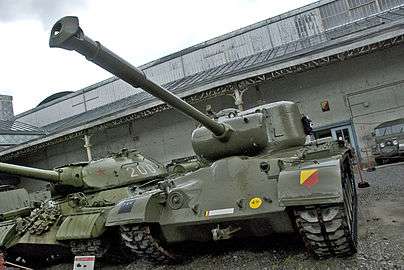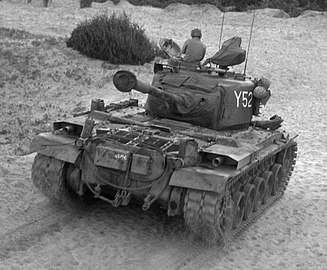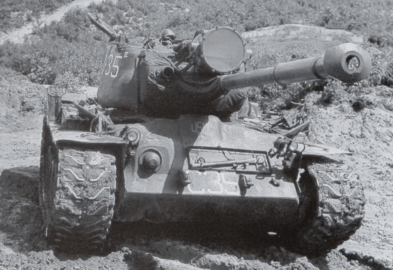M46 Patton
The M46 Patton was an American medium tank designed to replace the M26 Pershing and M4 Sherman. It was one of the U.S Army's principal medium tanks of the early Cold War, with models in service from 1949 until the mid-1950s. It was not widely used by U.S. Cold War allies, being exported only to Belgium, and only in small numbers to train crews on the upcoming M47 Patton.
| M46 Patton | |
|---|---|
An American M46 Patton tank of the United States Marine Corps, during the Korean War | |
| Type | Medium tank[1]:35 |
| Place of origin | United States |
| Service history | |
| In service | 1949–1957[2] |
| Used by | See Operators below |
| Wars | Korean War |
| Production history | |
| Designed | 1948–1949 |
| Manufacturer | Detroit Arsenal Tank Plant |
| No. built | 1,160 (all variants)[2] |
| Variants | |
| Specifications | |
| Mass | 97,003 lb (48.502 short tons; 44.000 t)[2] |
| Length | 31.17 ft (9.50 m)[2] |
| Width | 11.48 ft (3.50 m)[2] |
| Height | 10.37 ft (3.16 m)[2] |
| Crew |
|
| Armor | Up to 102 mm (4.0 in)[2] |
Main armament | |
Secondary armament |
|
| Engine | Continental AV-1790-5A V12, air-cooled Twin-turbo gasoline engine[2] 810 hp (600 kW)[2] |
| Power/weight | 18.4 hp (13.7 kW) / tonne |
| Transmission |
|
| Suspension | Torsion bar suspension[2] |
| Ground clearance | 18.82 in (478 mm) |
| Fuel capacity | 232 U.S. gal (880 l) |
Operational range | 81 mi (130 km)[2] |
| Maximum speed | 30 mph (48 km/h)[2] |
The M46 was the first tank to be named after General George S. Patton Jr., commander of the U.S. Third Army[1] during World War II and one of the earliest American advocates for the use of tanks in battle.[nb 1]
History
After World War II, most U.S. Army armored units were equipped with a mix of M4 Sherman and M26 Pershing tanks. Designed initially as a heavy tank, the M26 Pershing tank was reclassified as a medium tank after the war. The M26 was a significant improvement over the M4 Sherman in firepower and protection. Its mobility, however, was deemed unsatisfactory for a medium tank, as it used the same engine as the much lighter M4A3 and was plagued with an unreliable transmission.
Work began in January 1948 on replacing the original power plant with the Continental AV1790-3 engine and Allison CD-850-1 cross-drive transmission. This design was initially called the M26E2, but modifications continued to accumulate; eventually, the Bureau of Ordnance decided that the tank needed its own unique designation, the M46.[2] The upgraded M26 received a new power plant and a main gun with a bore evacuator.
Upon completion of the first model of the Detroit Tank Arsenal production line in November 1948, the M46 was christened after the late General George S. Patton.[4] By December the Army had ordered several hundred.[5] In July 1950 Detroit Arsenal was producing Pershings and M46s at a rate of over a dozen a day.[6] In August 1950 President Harry S. Truman authorized funding for increased M46 production as part an expansion of heavy tank development program.[7]
A total of 1,160 M46s of all variants were built.[2]
Combat service
The only American combat use of the M46 Patton was during the Korean War. On 8 August 1950, the first M46 Patton tanks, belonging to the 6th Tank Battalion, landed in South Korea. The M46 proved to be capable against North Korean T-34 medium tanks.[8] By the end of 1950, 200 M46 Pattons had been fielded, forming about 15% of US tank strength in Korea; the balance of 1,326 tanks shipped to Korea during 1950 were 679 M4A3 Shermans (including the M4A3E8 variant), 309 M26 Pershings, and 138 M24 Chaffee light tanks.[9]:39-40 Subsequent shipments of M46 and M46A1 Pattons allowed all remaining M26 Pershings to be withdrawn during 1951, and most Sherman equipped units were also reequipped.[10]:52,75-86
M46 series operators include: 1st Tank Battalion and regimental Antitank Platoons of the 1st Marine Division by 1952, 72nd Armor Regiment of the 2nd Infantry Division by January 1952, 64th Tank Battalion of the 3rd Infantry Division, 73rd Tank Battalion of the 7th Infantry Division by January 1951, 6th Tank Battalion of the 24th Infantry Division, 140th Tank Battalion (took over the tanks of the 6th Tank Battalion) and regimental tank companies of the 40th Infantry Division by October 1951,[10] and the 245th Tank Battalion of the 45th Infantry Division by 1952.[11]:29-32 Several other regimental tank companies gained M46/M46A1s by the end of the war, including the 7th and 65th Infantry Regiments of the 3rd Infantry Division.[12]:64-84
A surviving example of the M46 Patton tank can be seen on display at the War Memorial of Korea in Seoul.
In the 1950s, small numbers of M46s were leased for training purposes at no cost to some European countries, including Belgium, France and Italy, in preparation for the introduction of the M47. American instruction teams used the vehicles to train European tank crews and maintenance personnel.
Nuclear tests
On 1 June 1952 an M24 Chaffee Light tank and a platoon from the 1st Armored Division[13](pp3-4) took part in the Desert Rock atomic exercise,[14] the first test of armor in a nuclear blast.[15]
_001.jpg)
Variants
- M46 (Dozer) - Variant equipped with M3 dozer conversion kit.[2][16]
- M46A1 – Product improved variant with improved braking, cooling and fire suppression systems, as well as improved electrical equipment, AV-1790-5B engine and CD-850-4 transmission.[2]
- M46E1 – Pilot model, M46 hull with T42 turret, fitted with the M36 90 mm Gun, and was longer to incorporate a radio, ventilator, and featured a stereoscopic rangefinder; only one built.[17]:41,43[16] Prototype of the M47 Patton.
Operators

Former operators
Gallery
 M46 Patton tank and crew passing through the village of Kumko, Korea, in September 1950.
M46 Patton tank and crew passing through the village of Kumko, Korea, in September 1950.
 An M46 Patton tank of the United States Marine Corps, in July 1952, during the Korean War. Note the different rear plate and twin fender-mounted exhausts.
An M46 Patton tank of the United States Marine Corps, in July 1952, during the Korean War. Note the different rear plate and twin fender-mounted exhausts. M46 Patton with a searchlight
M46 Patton with a searchlight
See also
- List of armored fighting vehicles
- Centurion British tank
- T-54 Soviet tank
- M47 Patton
- M48 Patton
- M60 Patton
- M103 heavy tank
- G-numbers SNL G244
References
- Hunnicutt, R. P. (29 May 2015). Patton: A History of the American Main Battle Tank. Echo Point Books & Media. ISBN 978-1626541597. LCCN 84016586. OL 2854160M.
- "M46 Patton (General Patton)". militaryfactory.com. 21 May 2018. Archived from the original on 25 September 2004. Retrieved 2 March 2020.
- "Medium Tank M46 Patton". afvdb.50megs.com. 27 October 2019. Archived from the original on 17 August 2019. Retrieved 2 March 2020.
- "NEWEST TANK CHRISTENED; Widow of General Patton Takes Part in Detroit Ceremony". The New York Times. Associated Press. 12 November 1948.
- Baldwin, Hanson W. (13 December 1949). "New Tools of War: Aberdeen Echoes to Thunder of Bombs as New Equipment Tested". The New York Times. Retrieved 13 September 2018.
- "CADILLAC DIVISION TO PRODUCE TANKS; General Motors Says Work for Army Will Not Halt Civilian Output of Automobiles". The New York Times. 22 July 1950. Retrieved 13 September 2018.
- "Fund to Build Big Tanks Like Russia's Approved". The New York Times. The United Press. 30 August 1950. Retrieved 13 September 2018.
- Abel, Elie (8 January 1952). "Defective Tanks Pile Up In Depots". The New York Times. Detroit. Retrieved 13 September 2018.
DETROIT, Jan. 7 -- The new tanks rushed into production after the Communist assault on the Republic of Korea eighteen months ago have not yet been issued to the troops because they are unacceptable to the Army Field Forces.
- Zaloga, Steven J. (25 November 2000). M26/M46 Pershing Tank 1943–53 (New Vanguard). New Vanguard (Book 35). Illustrated by Tony Bryan and Jim Laurier (1st ed.). Osprey Publishing. ISBN 978-1841762029. OL 8922180M. Retrieved 2 March 2020.
- Boose, Donald (12 April 2005). US Army Forces in the Korean War 1950–53 (Battle Orders) (First ed.). Osprey Publishing. ISBN 978-1841766218. OCLC 869301559. OL 8922550M. Retrieved 2 March 2020.
- Dunstan, Simon; Hadler, Terry (15 June 1982). Armour of the Korean War 1950-53. Vanguard (Book 27) (First ed.). Osprey Publishing. ISBN 978-0850454284. OCLC 1052687218. OL 8264810M. Retrieved 1 March 2020.
- Thiel, Troy D. (11 March 2002). The M26 Pershing and variants: T26/M26, M26A1, M45, M46/M46A1 (1st ed.). Schiffer Publishing. ISBN 978-0764315442. LCCN 2001096784. OCLC 53092514. OL 22848191M.
- "Fact Sheet - Operation TUMBLER-SNAPPER" (PDF). dtra.mil. United States Department of Defense - Defense Threat Reduction Agency. 3 June 2015. Archived (PDF) from the original on 14 September 2017. Retrieved 3 March 2020.
Immediately after the shot, the troops, accompanied by five tanks, advanced from the trench area toward the objective.
- "ATOM 'GUN' FIRED AND G. I.'S 'CHARGE'; 1,000 Troops Advance in Face of Nevada Blast to Engage 'Enemy' Hit by 'Shell'". The New York Times. The United Press. 1 June 1952. Retrieved 13 September 2018.
- "TANK-AIDED TROOPS SET FOR ATOM TEST". The New York Times. The United Press. 30 May 1952. Retrieved 13 September 2018.
- "M46 PATTON SERIES OF MAIN BATTLE TANKS". jedsite.info. 2007. Archived from the original on 13 October 2007. Retrieved 2 March 2020.CS1 maint: unfit url (link)
- Mesko, Jim. M48 Patton in Action - Armor No. 22. Illustrated by Kevin Wornkey and Don Greer (1st ed.). Squadron/Signal Publications. ISBN 978-0897471657.
Notes
- although the Ordnance Committee Minutes/OCM #33476 ceased utilizing the heavy, medium, and light tank designations on 7 November 1950; going to the "...Gun Tank designation")[1]:14
Bibliography
- Rabinovich, Abraham (1972). The Battle for Jerusalem: June 5-7, 1967 (1st ed.). Jewish Publication Society of America. ASIN B0006C6MHM. ISBN 978-9657287071. OCLC 947062697.
- Nolan, Keith William (1987). Into Laos: The Story of Dewey Canyon II / Lam Son 719: Vietnam 1971 (1st ed.). Presidio Press. ASIN B005A96RI0. ISBN 978-0440200444. OCLC 17887412. OL 7518446M.